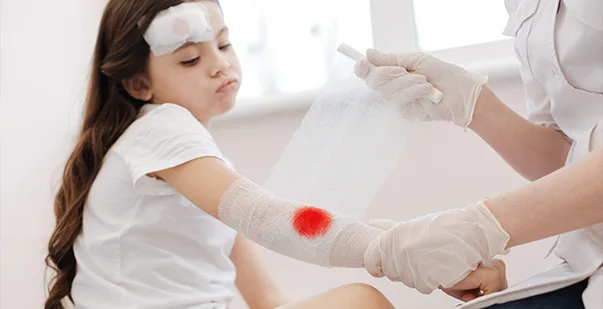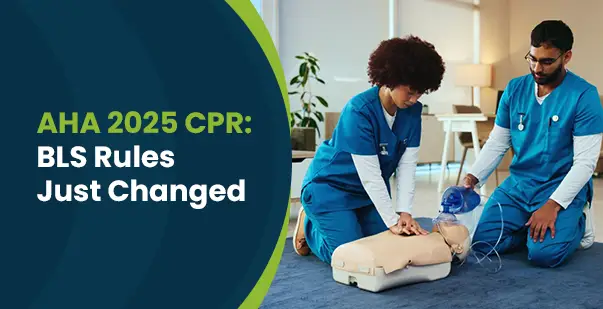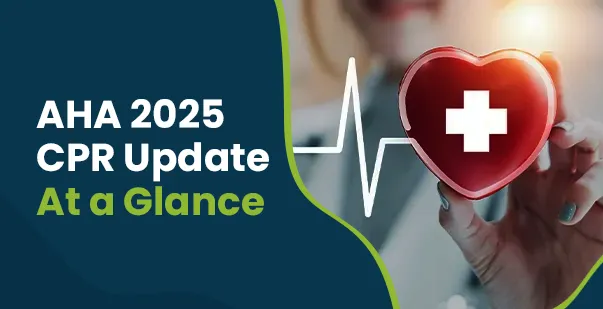Events of blood loss can be extremely traumatizing. Accidents happen, and rapid treatment is essential. If you are equipped with the knowledge of first aid and can differentiate between different types of bleeding, you will be able to intervene and save the victim.
Venous and arterial bleeding are two common types of blood loss that need immediate attention. Arterial bleeding happens when blood comes out quickly and can be easier to control but needs quick treatment. Venous bleeding happens when a vein is cut or damaged. This causes dark red blood to flow out. It does not spurt but needs quick attention.
Both of these bleeding types are critical. Read the blog further to compare artery vs vein.
What is Venous Bleeding?
Venous bleeding occurs when a vein is torn or cut. The color of the blood is dark red and moves slowly and steadily. It does not shoot out like arterial blood. Although venous bleeding does not look the same, it can be very serious. This type of bleeding flows steadily instead of spurting.
Veins carry blood back to the heart under lower pressure. Although it may not seem as urgent as arterial bleeding, it can cause blood loss when not treated timely. Apply direct pressure is crucial to control the bleeding
Online First Aid Training.
Prepare for real emergencies with our online First Aid Certification.
What is Arterial Bleeding?
Arterial bleeding occurs when an artery is damaged. This causes blood to come out in red color, especially due to the high oxygen content. Arteries carry oxygenated blood from the heart to the rest of the body. This is why blood flows out in spurts that sync with the heartbeat. This is dangerous, as the rapid blood loss can cause death if not treated promptly. Arteries carry oxygen-rich blood from the heart to the body. Hence, the blood comes out with each heartbeat. This makes it harder to control. Direct pressure and a tourniquet helps stop arterial bleeding effectively. You must address the bleeding immediately to stop and prevent complications.
What are the Differences between Venous Bleeding and Arterial Bleeding?
Here is a table describing differences in bleeding of arteries vs veins:
| Criteria | Venous bleeding | Arterial bleeding |
| Source of bleeding | It occurs from veins that carry deoxygenated blood to the heart. | Occurs from arteries which carries oxygenated blood away from the heart |
| Color of blood | Darker red due to lower oxygen levels in the blood | Bright red due to high oxygen content |
| Flow of oxygen | Blood flows out slowly and can pool | Blood spurts out in sync with the heartbeat |
| Pressure | Lower pressure as compared to arterial bleeding | High pressure which makes it difficult to control |
| Severity | Less severe than arterial bleeding but still needs attention | Extremely severe and can be life-threatening |
| Control capability | Easier to control with direct pressure and elevation | Very difficult to control and requires a tourniquet in severe cases |
| Associated symptoms | Swelling or bruising at the wound site | May cause shock, pale skin, rapid heartbeat and loss of consciousness. |
| Common causes | Caused by cuts or lacerations to veins, such as deep cuts | Caused by severe trauma or deep injuries to arteries |
| First aid approach | Apply direct pressure, elevate the wound and use clean dressings | Firm pressure and a tourniquet may be required to slow or stop bleeding. |
| Risks | Can cause blood loss or infections like septicemia, skin infections like cellulitis, and deep vein thrombosis | Can cost shock, blood loss and even death |
What does Venous Bleeding Look Like?
When a vein is torn, the blood that flows out will be dark red or bluish. This is because it no longer has oxygen. Additionally, since venous blood is moving to the heart, it is under less force as compared to arterial blood. It will ‘ooze’ like a liquid and flow steadily out of the body. If the damaged vein is deep or large, it may cause the blood to gush out.
Venous bleeding may occur from the following wounds:
- Punctures
- Lacerations
- Amputations
What are the Signs and Symptoms of Venous Bleeding?
Venous bleeding requires prompt care to prevent complications. Here are signs and symptoms of venous bleeding:
- Steady, dark red blood flow
- Bleeding may pool near injury.
- Sweeping or bruising around the wound
- Can cause lightheadedness if too much blood loss happens.
- May cause visible damage to surrounding tissues or veins
- Blood flows out slowly as compared to arterial bleeding.
What are the Signs and Symptoms of Arterial Bleeding?
Arterial bleeding is a medical emergency caused by damage to an artery. This results in severe blood loss. Due to high pressure in arteries, the blood comes out in sync with the heartbeat and is bright red. Here are the signs and symptoms of arterial bleeding:
- Bright red blood is spurting rhythmically.
- Rapid blood loss, often difficult to control
- Pale skin and signs of shock like shock symptoms dizziness, fainting, rapid breathing.
- Blood spurting in time with the heartbeat
- Loss of consciousness in severe cases due to heavy blood loss
- Cool, clammy skin
First Aid Treatment for Venous Bleeding
Venous bleeding can be controlled with proper first aid measures. This helps in reducing the risk of excessive blood loss or infection. Apply direct pressure and elevate the wound to slow the bleeding. If this is managed well, this bleeding is easier to control. Here are the first aid treatments offered:
Apply direct pressure
Use a clean cloth or bandage to press firmly on the wound. The pressure helps slow the bleeding by compressing the vein. It allows the blood to clot. Continue applying pressure until the bleeding stops.
Elevate the Affected Area
Raise the injured limb above the heart level, if possible. Elevation reduces blood flow to the injury. This makes it easier to control the bleeding. Make the patient feel comfortable while doing this.
Use a clean dressing
Once the bleeding slows, cover the wound with a sterile dressing or bandage. This helps protect the area from infection and keeps the wound clean. Change the dressing regularly to prevent infection.
Avoid removing embedded objects
If there’s an object embedded in the wound, do not remove it. This can further damage and worsen the bleeding. Instead, apply pressure around the object and seek medical assistance.
Monitor for Signs of Shock
Keep an eye on the injured person for symptoms like pale skin, which could indicate shock. If signs of shock are present, lay the person down and elevate their legs slightly to promote blood flow to vital organs.
Seek medical attention
Have a medical professional check the injury. Venous bleeding can still lead to complications like infection or deeper tissue damage. Always ensure the wound is evaluated and properly treated by a healthcare provider.
Read more: How to Stop Bleeding: A Guide to Stopping Bleeding
First Aid Treatment for Arterial Bleeding
Arterial bleeding is life-threatening due to the forceful loss of blood. You must act immediately to prevent blood loss and death. Here are a few easy steps to provide first aid treatment for arterial bleeding:
Call for Immediate Medical Help
Always call emergency services as soon as arterial bleeding is suspected. Arterial bleeding requires urgent medical intervention. Continuously monitor and treat well to prevent life-threatening complications.
Elevate the Limb (If Possible)
If the wound is on a limb, raise it above heart level. This reduces the blood flow to the injured area and helps to slow the bleeding. Be careful not to move the injured limb too much to avoid worsening the injury.
Use a tourniquet (if trained)
If the bleeding cannot be controlled with pressure and you’re trained to do so, apply a tourniquet above the wound. Tighten it until the bleeding stops. Note the time of application and loosen the tourniquet every 10-15 minutes to avoid tissue damage. Do this only if you do not get professional help.
Cover the wound with sterile dressing
Once the bleeding is somewhat controlled, cover the wound with a sterile bandage. This helps prevent infection. Keep applying firm pressure over the dressing.
Monitor for Signs of Shock
Arterial bleeding often leads to shock. Monitor the injured person for symptoms like rapid breathing, pale skin, or fainting. If signs of shock are present, lay the person down, elevate their legs, and keep them warm with a blanket.
How Do You Identify Arterial vs. Venous Bleeding in an Emergency?
During an emergency, identify whether bleeding is arterial or venous. This can help in determining the severity and type of treatment required. It is crucial to distinguish between the two to offer faster and more effective help.
- Observe the color of blood
Arterial bleeding produces bright red blood. Venous bleeding is darker and more maroon. - Check the flow pattern
Arterial bleeding spurts rhythmically with each heartbeat. On the other hand, venous bleeding flows continuously in a steady stream. The pressure causes the blood to spurt in sync with the heart’s pumping action. Venous bleeding however flow continuously as veins carry blood back to the heart at a much lower pressure as compared to arteries. Hence, there is no rhythmic spurting. - Evaluate the bleeding speed
- Arterial bleeding is rapid and difficult to control. This leads to significant blood loss quickly. Venous bleeding is slower and more consistent.
- Assess the pressure
Arterial bleeding results from high pressure. This makes it more forceful. On the other hand, venous bleeding is lower pressure and less forceful. - Look for other symptoms
In arterial bleeding, signs of shock or unconsciousness may occur rapidly due to faster blood loss. Venous bleeding can cause swelling but is less likely to lead to immediate shock.
What are the Long-Term Complications of Untreated Arterial and Venous Bleeding?
Untreated arterial and venous bleeding can cause long-term complications that affect health and organ function. Here are some long-term complications of untreated arterial and venous bleeding:
Severe blood loss and shock: Uncontrolled arterial bleeding can cause hypovolemic shock, where the body loses too much blood to maintain vital functions. This can lead to organ failure or death if not treated immediately.
Infection and tissue damage (venous bleeding)
Without proper treatment, venous bleeding can cause infections at the wound site. Persistent blood pooling may also damage surrounding tissues. This leads to long-term healing problems or necrosis. Necrosis is the death of cells or tissue in the body. This is caused due to lack of blood flow, injury or infection. When cells die, the tissue cannot function well. This may turn black and can be damaged.
Organ Failure (Arterial Bleeding)
Major blood loss from untreated arterial bleeding can reduce oxygen supply to critical organs like the brain, heart, and kidneys. Prolonged deprivation can cause irreversible organ damage or failure.
Chronic Swelling and Venous Insufficiency (Venous Bleeding)
Untreated venous bleeding can contribute to long-term venous insufficiency. Blood does not flow back to the heart efficiently. This leads to chronic swelling, pain, and ulcers in the affected area.
Permanent Disability (Arterial Bleeding)
If major arteries are affected, untreated bleeding can result in permanent disability. This causes a loss of blood flow to the limbs. This further leads to tissue death and, in some cases, amputation. Amputation is when a part of the body is surgically removed due to damage or disease. The process helps prevent health problems and improves the person’s overall well-being.
Increased risk of blood clots (venous bleeding)
Prolonged venous bleeding or damage can increase the risk of developing blood clots (deep vein thrombosis). This can potentially lead to life-threatening conditions like pulmonary embolism. A pulmonary embolism is when a blood clot blocks one of the arteries in the lungs. This makes it hard to breathe and causes chest pain. It is serious and must be treated quickly.
Read more: 9 Basic Life-Saving Skills That Will Help You Save A Life
First Aid Training Made Easy
Learn essential first aid care from anywhere with our online course
Take Action to Prevent Life-Threatening Consequences.
Know the difference, artery vs vein and act quickly to save lives. Do not wait until it is too late. Prepare yourself for any emergency and learn first aid techniques. If you or someone else experiences severe bleeding, you must seem immediate help. Stay informed, be ready, and protect yourself and others around you. Enroll in a first aid course today to learn more about veins vs artery and gain the skills and be confident.









